.
N - O - P - Q - R - S - T - U - V - W - X - Y - Z
Scallop dredgers
according to Aristotle.
Screw
around 550 BC by Archytas who also invented the pulley and a child's rattle. (Later further developed by Archimedes) How Archimedes Screwed the Oligarchy
Screw (pump) of Archimedes
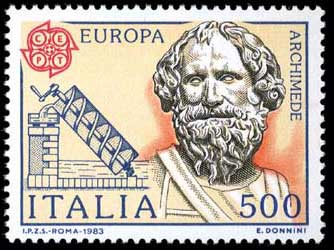
A stamp with a screw of Archimedes. The image of Archimedes is from a bust in the National Museum of Naples, Italy. However, the bust actually is one of Archidamos III, a third-century BC king of Sparta.
The invention of the water screw is tied to the study of the spiral, for which Archimedes wrote a treatise entitled On Spirals, in 225 BC. This pump is an ingenious device functioning in a simple and elegant manner by rotating an inclined cylinder bearing helical blades around its axis whose bottom is immersed in the water to be pumped. As the screw turns, water is trapped between the helical blades and the walls, thus rises up the length of the screw and drains out the top. Archimedes screw marks the beginning in the development of the ship propeller. In the 18th century many projects, plans and tests were conducted in England, France and America, but they all failed. Eventually the first steamers were constructed with paddles. But two men continued the experiments: the Austrian Joseph Ressel and the British Francis Petitt Smith. From 1812 to 1826 Ressel built a working propeller and in 1839 Smith developed a screw which was actually installed on the steamer 'Archimedes'.
Archimedes screw was used for agricultural irrigation in Egypt (a result of the visit of Archimedes in Egypt as Diodorus Siculus describes), for mine drainage in Roman mines in France and Spain and as a bilge pump for the giant Syracusia ship.
Ancient Sources about Archimedes Screw , A possible use of the Archimedes screw
See Illustrations and Animations and more Information
An unusual fossil colony of bryozoans Archimedes (Screw)
References. Demetris Koutsoyiannis, Water resources technologies in the ancient Greece, School of Civil Engineering National Technical University of Athens

The Archimedes Elevator, based on the Archimedes screw
Sea Mines
The Greeks developed the first sea mine in the seventh century BC. A hellish discovery credited to Callinicus its formula is lost to history, but may have contained sulphur, naphtha and nitre. The Greeks filled barrels with their fomular and set them on fire, tide or current would move them toward an enemy ship and upon contact set the vessel on fire. Interestingly, this first sea mine could also be used as a land-based or ship-based weapon. The Greeks learned that they could use a device called the "Petrary or Petad," a type of early catapult. They would light the "Greek Fire" and launch it from a ship or from land to hit targets on land or at sea. The flaming barrels must have struck fear in enemies. Robert-Ian Salit A SHORT HISTORY OF MINE SWEEPING 4TH INTERNATIONAL SYMPOSIUM ON TECHNOLOGY AND THE MINE PROBLEMNaval Postgraduate School, Monteray, CA. – March 12-16, 2000
Sequence Control
Heron of Alexandria described a mechanism or apparatus that made use of the so called "sequence control" mechanism. This mechanism used drums in which pins and gears were mounted to control events that 'laid ahead'. Sequence control gives means to foretell the outcome of a sequence of events in advance, without influencing the outcome directly. Examples of sequence control are a music box with a drum on which pins are attached that strike against the teeth of a comb. Teeth that have predefined lengths and thus possess their own tone. By striking teeth in a predefined sequence a melody will sound. Sequence control is defined as a lower generation of computer programs. The operator feeds machines like that with certain limited input and lets the machine run on its own without external control for the outcome: actions to move mechanical contraptions, music or calculations.
Shock-Absorber
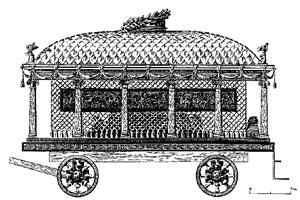
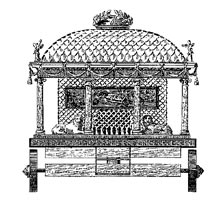
Alexander's funeral carriage
shock-absorber invented for Alexander's funeral carriage (Diodorus Siculus, XVIII, 26, 27, 28) a wheeled monument on which the body of the hero was laid, was pulled all the way to Alexandria via Memphis. Alexanders body was placed in a gold anthropoid sarcophagus which was then encased in a second gold casket and covered with a purple robe. Alexander's coffin was placed, together with his armor, in a gold carriage which had a vaulted roof supported by an Ionic peristyle. The decoration of the carriage was very rich and is described in great detail by Diodorus.
Shower
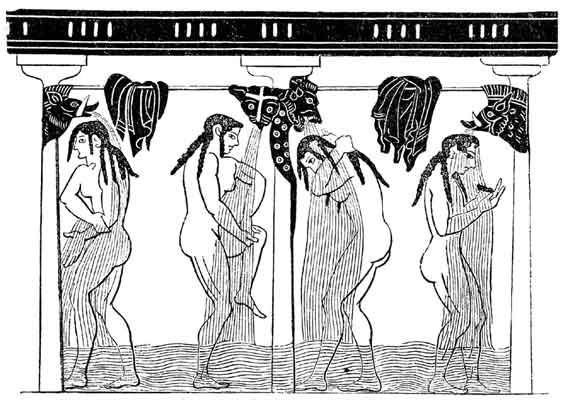
But the first real showers, with plumbed-in water, were invented by the ancient Greeks. After exerting themselves in the stadium, ancient Greek athletes would freshen up in the kind of shower depicted on an Athenian vase of the fourth century B.C. Two shower rooms are shown, occupied by four rather muscular young ladies. Piped-in water sprays down on the bathers through showerheads shaped like the faces of boars and lions. (from www.inventions.org See: )
See also Greek Baths
Siege machines
350 BC. Development of siege machines by Philip. Aineias Taktikos On the defence of a besieged city. See the Helepolis of Demetrius.
Siren
invented by Philo of Byzantium ( 260-180 BC). It worked with steam and was used as an acustic signal emitter for lighthouses. Philo was one of the most important engineers of the Hellenistic period. He describe various devices that work with air or steam. (That shows that Heron's aeolipile is not the only device that uses steam).
Soldering of Iron
by Glaucus of Chios (gr. Glaukos) around 600 BC.
See
Soap
Greek soap was manufactured from a combination of goat fat and ashes. Soap was discovered at Sappo Hill in Greece. The ancient Greeks traveled to this sacred place to give burnt offerings to the gods. They would sacrifice animals over an open fire and the grease or tallow would drip into the coals of the fire. Later, it would rain and the water would percolate through the ashes of the fire. This would result in the natural formation of lye which would act upon the fat remaining in the fire pit and would saponify this soap thus making natural soap. Soap is nothing more than fat which has been converted into soap through the chemical action of the lye (or sodium hydroxide) with the fat. The Scythians of Ukraine probably as early as the 7th century B.C. were using soap to wash their hair according to the Greek historian Herodotus. Another source is at 275 BC Theocritus Idyll 15 (smema). We also know that Ancient Greeks used the sap of a plant called saponaria.
Steam Engine (or in principle a jet engine)

Image Source , A modern version can perform more than 3500 rotations per minute
Heron, described in detail what is thought to be the first working steam engine, which was obviously not very efficient. He called it an aeolipile, or "wind ball". His design was a sealed caldron of water was placed over a heat source. As the water boiled, steam rose into the pipes and into the hollow sphere. The steam escaped from two bent outlet tubes on the ball, resulting in rotation of the ball. The aeolipile is the first known device that could transform steam into rotary motion. The principle he used in his design is similar to that of today's jet propulsion. The steam engine reappeared again only in 1698 when Thomas Savery invented a steam pump. The first practical steam engine was the atmospheric machine of Thomas Newcomen in 1701. It was used to operate pumps on coal mines. In 1804, English inventor Richard Trevithick introduced the steam locomotive in Wales. In 1815, George Stephenson built the world's first workable steam locomotive. A jet propelled wagon utilizing the aeolipile appeared in early textbooks on the evolution of the horseless carriage.
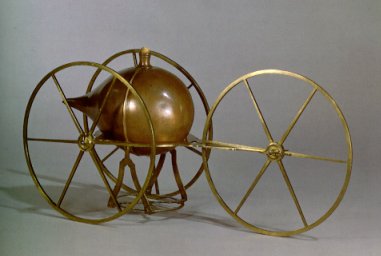
Jean-Antoine Nollet, Leçons de Physique Expérimentale, 1764, Vol. IV
The simple technology was not sufficient to power horseless carriages. Denis Papin (1647-1712) who invented 1679 the pressure cooker and in 1690 published his first work on the steam engine in De novis quibusdam machinis knew the aeolipile from Heron's pneumatica, translated by Gottfried Wilmhelm Leibniz (1646-1716), Germany.
Steam Gun of Archimedes

Archimedes Canon, Leonardo Da Vinci:
A description is given by Christos Lazos in Greek
Για το ατμοτηλεβόλο (ή ατμοπυροβόλο) οι μοναδικές ιστορικές μαρτυρίες που έχουμε προέρχονται από τον Ιταλό ποιητή Φραγκίσκο Πετράρχη (1304-1374), που μτλά γι’ αυτό στο έργο του De remediis utriusque fortunae και τον περίφημο μηχανικό και ζωγράφο Λεονάρντο ντα Βίντσι (1452-1519) που είχε πιθανότατα στη βιβλιοθήκη του σχετικό χειρόγραφο του Αρχιμήδη. Ο Ντα Βίντσι προχώρησε στο σχεδιασμό του οργάνου, αλλά όχι στην κατασκευή του ατμοτηλεβόλου, το οποίο ονόμασε «αρχιτρόνιτο» προς τιμήν του Αρχιμήδη. Μας παρέδωσε τρεις απεικονίσεις του οργάνου πάνω στις οποίες στηρίχθηκε ο Ι. Σακάς για την ανακατασκευή του. Το ατμοτηλεβόλο του Ι. Σακά ήταν μοντέλο σε αναλογία 1/5 και στις 12 Μαΐου 1981 έγινε δημόσια επίδειξη κατά την οποία πραγματοποιήθηκαν βολές που έφτασαν σε μήκος τα 50 μέτρα. Το πείραμα έλαβε χώρα σε ακάλυπτη περιοχή στα Άνω Βριλήσσια της Αττικής παρουσία πολλών αντιπροσώπων του ελληνικού και ξένου Τύπου. Ένας από αυτούς, ο Πέτρος Μακρής, σε κείμενο του στην εφημερίδα «Ελευθεροτυπία», της 15ης Μαΐου 1981, μεταξύ άλλων έγγραφε και τα εξής: «Η πολεμική μηχανή του Σακά είναι κατά πέντε φορές μικρότερη από εκείνη του Αρχιμήδη και είναι κατασκευασμένη με τα ίδια υλικά που χρησιμοποίησε ο μεγαλύτερος μηχανικός της αρχαίας Ελλάδος και ίσως του κόσμου, μέχρι σήμερα. Δηλαδή αποτελείται από ξύλινη κάνη, λέβητα νερού, χάλκινο κύλινδρο και σφαιρικά βλήματα... Ο Έλληνας μηχανικός άναψε φωτιά με ξερόκλαδα κάτω από το λέβητα του τηλεβόλου. Μετά από ένα γερό ζέσταμα του καζανιού γέμισε από εμπρός την κάνη του τηλεβόλου με τσιμέντινη σφαιρική μπάλα, στο μέγεθος μπάλας του τένις. Για να δημιουργηθεί πίεση αρκετών ατμοσφαιρών -σύμφωνα πάντοτε με το σχέδιο του Αρχιμήδη- ο κ. Σακάς εμπόδισε την έξοδο της σφαίρας με μικρό ξύλινο δοκάρι. Μόλις η επιφάνεια του λέβητα θερμάνθηκε στους 400 βαθμούς Κελσίου, ο κ. Σακάς έριξε σ’ ένα μικρό σωλήνα του τηλεβόλου μόνο 6 γραμμάρια νερού που έγινε στα 10 δευτερόλεπτα ατμός, ο οποίος με χειροκίνητη βαλβίδα διοχετεύθηκε στην κάννη. Η πίεση αυτή του ατμού ήταν αρκετή για να σπάσει το δοκάρι που έφραζε την έξοδο της κάνης και να πετάξει την μπάλα σε απόσταση 50 μέτρων» .
The mechanism is described by Francisco Petrarch (1304 -1374) in his work remediis utriusque fortunae and Leonardo Da Vinci (1452 – 1519) had a knowledge about this device probably from a manuscript of Archimedes. Da Vinci named this invention Architronito in honour of Archimedes. He produced only drawings of the steam gun. Ioannis Sakas , a Greek expert of the work of Archimedes used this information to build the steam gun and to test the device in 12.5.1981. A vessel was heated and when it reached 400 degrees Celsius 6 g of water was enough to produce in 10 seconds steam that expanding could throw a tennis ball size stone 50 meters. The reconstructed Archimedes steam gun by Sakas was only 1/5 the size of the original. A Greek newspaper reported 3 days later about the result of the experiment of Sakas. From another Greek website the numbers which are given for the original is that it was able to shoot a 23 kg stone in 1100 meters and it was invented by Archimedes probably around 213 BC http://www.ellinikiestia.gr/PTYXES/antechn/atmotilebolo-toy-arximidi1.jpg
Πολεμική Τεχνολογία στην Αρχαία Ελλάδα : Τα Τηλεβόλα και οι Αρχές της Βλητικής (Report in Greek)
BOOKS
Stentorophonic tube
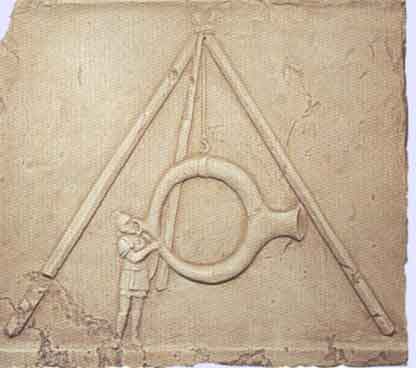
An application of sound-signaling was worked out for Alexander the Great, which was considered one of the scientific wonders of Antiquity. This was called a stentorophonic tube, and seems to have been a sort of gigantic megaphone or speaking-trumpet. It is recorded that it sent the voice for a dozen miles. A drawing of this strange instrument is preserved in the Vatican. , Communication among the Ancients, Walter Kellogg Towers
(Stentor is a figure of Greek Mythology)
A - B - C - D - E - F - G - H - I- J - K - L - M -
N - O - P - Q - R - S - T - U - V - W - X - Y - Z
| Ancient Greece
Science, Technology , Medicine , Warfare, , Biographies , Life , Cities/Places/Maps , Arts , Literature , Philosophy ,Olympics, Mythology , History , Images Medieval Greece / Byzantine Empire Science, Technology, Arts, , Warfare , Literature, Biographies, Icons, History Modern Greece Cities, Islands, Regions, Fauna/Flora ,Biographies , History , Warfare, Science/Technology, Literature, Music , Arts , Film/Actors , Sport , Fashion --- |

